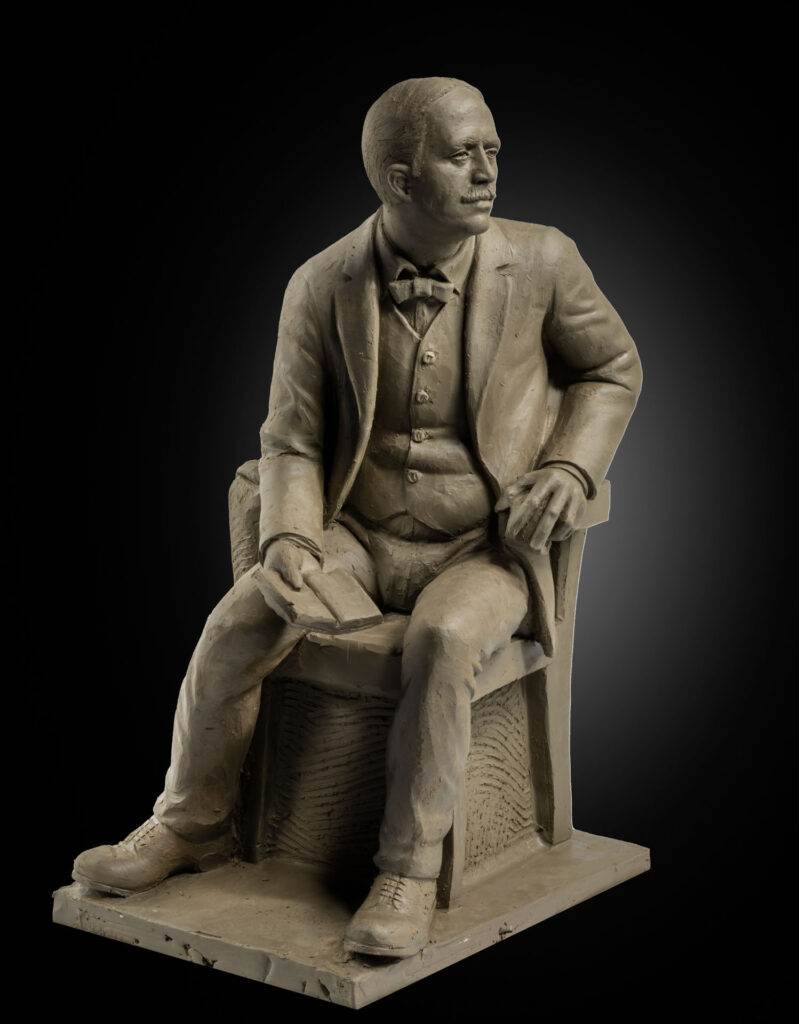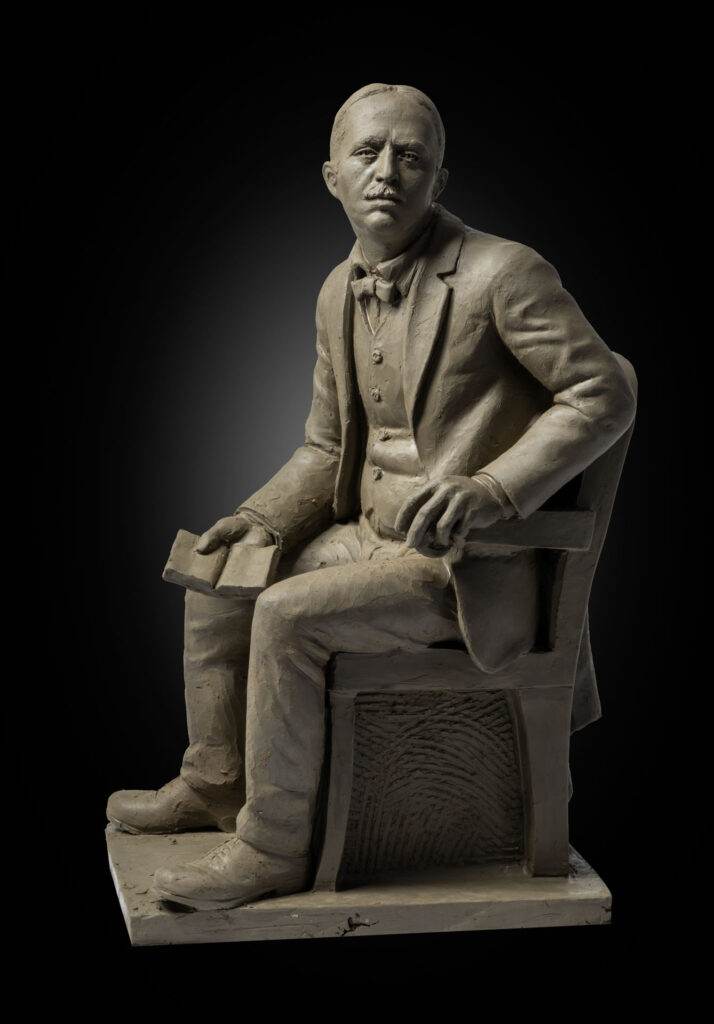Dr. Charles Caverly was world’s first to identify polio epidemic
The 13th addition to the Rutland Sculpture Trail will honor a groundbreaking Rutland doctor, and the hundreds of local medical professionals who responded to the Covid-19 pandemic.
The sculpture, designed by and to be carved from Danby White marble by Italian sculptor Alessandro Lombardo, will feature Dr. Charles Caverly, a Rutland doctor who identified the first polio epidemic in the world, in Rutland County in 1894. Sporadic cases of paralysis and related symptoms began to appear around the world in the mid-1800s, but they were not typically connected, and a diagnosis remained elusive, until Caverly began to investigate and treat a series of sick patients.


Caverly, a young doctor in Rutland, was the first to make the connection among a slew of cases. Caverly couldn’t determine what caused the disease, but according to the American Association of Immunologists, his diligence laid the groundwork for substantial understanding of polio. He reached three important conclusions that affected the world’s medical community’s understanding of the illness, namely that polio had the potential to become an epidemic; most of the victims were children, not infants, thus the common name for the disease: “infantile paralysis” was wrong; and some victims experienced an extremely mild form of the illness and quickly recovered. These findings would help inform other researchers’ work to combat the disease, which could cause life-altering paralysis or kill infected patients.
Caverly had been in practice barely 10 years when he identified an outbreak of polio in the region in summer 1894. Polio and its permanent paralysis of young people had been described sporadically around the world for decades, and an occasional cluster of five or 10 cases had been noted by physicians elsewhere. But in that fateful summer, Caverly diagnosed polio in 132 patients in the Rutland area, exceeding by 10-fold the largest outbreak ever described anywhere else in the world.
He reported that 18 of the victims died, ranging in age from 4 months to 38 years. When his findings were published, it caused a sensation throughout the medical world. Rutland had perversely made the medical history books.
Caverly attended Brandon High School, Kimball Union Academy, and Dartmouth College before earning his medical degree from the University of Vermont. He settled in Rutland, established a thriving practice, was appointed the city’s first health officer, and in 1891 was appointed president of the Vermont State Board of Health.
When he was confronted in 1894 by those 132 polio cases, he was well-poised to recognize the scope of the epidemic and well-equipped to sound the alarm throughout the state and nation, and around the world. The bacterial source of communicable diseases had been established and was widely accepted by the medical community by that time, but no bacteria could be identified in any of the stricken patients and even in large families usually only a single person, almost always a child, was afflicted. The polio virus would not be identified until 1909.
Caverly continued his Rutland practice and followed closely the emerging science of infectious disease. Importantly, he recognized that people could contract a mild form of polio, what he called “abortive cases” and never develop paralysis, and further noted that patients who developed paralysis initially presented with headaches, fatigue, fever and nausea. He also became convinced that patients who had recovered from the paralysis stage of polio were immune when exposed to subsequent outbreaks.
Polio epidemics continued to plague Vermont in the ensuing decades. Rutland had a smaller outbreak in 1910 (24 cases over three years) and Montpelier had an even bigger outbreak in 1917. Still president of the Vermont State Board of Health and now armed with new knowledge about the disease’s origins and transmissibility, Caverly instituted home quarantines and banned large public gatherings to control it.
His interest in public health ultimately led him to study the other scourge of that era, tuberculosis. He advocated for a sanitorium for TB patients, and under his direction, the Vermont Sanitorium was established in 1907 in Pittsford, based on a determination that the town had the highest daily incidence of sunlight in the state. The sanitorium operated into the 1960s, when medical treatment for tuberculosis allowed its closure.
The great irony of Caverly’s life is that he was the first in the world to recognize a polio epidemic, but he succumbed to another epidemic that hit Rutland, the influenza pandemic in 1918. He was just 62.
The parallels between Caverly’s struggle to diagnose, treat and prevent polio epidemics more than 100 years ago and the world’s struggle with the Covid-19 pandemic today are many: the initial uncertainty and fear, the constant evolution of science, the spread of disease by a mobile society, the public’s widespread but not universal embrace of quarantines, the banning of public gatherings and social distancing, the search for a vaccine (realized finally for polio with the Salk vaccine of the 1950s) and the recognition that immunity may be conferred on those who survive. As a result, the sculpture will be dedicated to Rutland Regional Medical Center employees and other regional medical personnel who lead Rutland County through the early days and months of the Covid pandemic.
The Caverly sculpture, planned for completion and installation this fall, is being funded through generous donations from the Rutland Health Foundation, Dave and Lyn Wolk, Jane and Steve Costello, Claudio and Brenda Fort, Dr. Mel and Lynn Boynton, Rutland Regional Medical Center senior medical staff, Mountain Cider Company, and Rutland City Rotary.
“Dr. Caverly made an incredible contribution to the world in first identifying a polio epidemic, which had worldwide impacts,” said Dr. Mel Boynton. “This statue will honor not only Dr. Caverly, but also all of Vermont’s health professionals who worked day and night to treat patients during the Covid-19 epidemic.”
“Dr. Caverly was an inspiration to my Dad and his own public health volunteerism throughout his career,” Dave Wolk said. “One of the highlights of my childhood was being lucky enough to accompany him once a month on a Sunday where he took care of 46 children all at once, and all as a volunteer. Sometimes those were long days, but heartwarming ones. It’s what Dr. Caverly would have done.”
The Rutland Sculpture Trail is a collaboration of the Carving Studio and Sculpture Center, Vermont Quarries, Green Mountain Power, and MKF Properties. The Rutland Sculpture Trail was started in 2017 to raise awareness of and pride in local and regional history, beautify downtown, and draw local residents and tourists to Rutland’s historic downtown. It is funded by private donations, with each piece of art donated as a gift to the City of Rutland.




